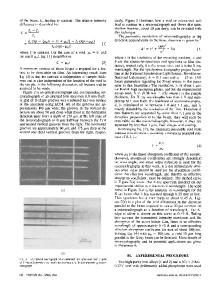Creep damage properties of sandstone under dry-wet cycles
- PDF / 1,255,564 Bytes
- 11 Pages / 595.22 x 842 pts (A4) Page_size
- 3 Downloads / 333 Views
e-mail: [email protected]
http://jms.imde.ac.cn https://doi.org/10.1007/s11629-020-6284-z
Creep damage properties of sandstone under dry-wet cycles WANG Xin-gang1,2,3 LIAN Bao-qin1*
https://orcid.org/0000-0002-1744-8712; e-mail: [email protected]
https://orcid.org/0000-0002-3419-5040;
e-mail: [email protected]
WANG Jia-ding1
https://orcid.org/0000-0002-4315-7097; e-mail: [email protected]
FENG Wen-kai3
https://orcid.org/0000-0001-7747-8836; e-mail: [email protected]
GU Tian-Feng1
https://orcid.org/0000-0002-8027-5797; e-mail: [email protected]
*Corresponding author 1 State Key Laboratory of Continental Dynamics, Department of Geology, Northwest University, Xi’an 710069, China 2 Guangxi Key Laboratory of Disaster Prevention and Engineering Safety, Guangxi University, Nanning 530004, China 3 State Key Laboratory of Geohazard Prevention and Geoenvironment Protection, Chengdu University of Technology, Chengdu 610059, China Citation: Wang XG, Lian BQ, Wang JD, et al. (2020) Creep damage properties of sandstone under dry-wet cycles. Journal of Mountain Science 17. https://doi.org/10.1007/s11629-020-6284-z
© Science Press, Institute of Mountain Hazards and Environment, CAS and Springer-Verlag GmbH Germany, part of Springer Nature 2020
Abstract: Rock creep properties can be used to predict the long-term stability in rock engineering. In reservoir bank slopes, sandstones which are frequently used in the bank slope undergoing longterm effects of dry-wet (DW) cycles due to periodic water inundation and drainage may gradually accumulate creep deformation, resulting in rock structure’s damage or even geological hazards such as landslides. To fully investigate the effect of DW cycles on the creep damage properties of sandstone, triaxial creep tests were conducted on saturated sandstone with different DW cycles by using a triaxial rheometer apparatus. The experimental results show that both the instantaneous strain and the stabilized strain increase with the DW cycles. In addition, using the Burgers model, four kinds of functions including an exponentially decreasing function, a linearly decreasing function, a linearly increasing function and an exponentially increasing function were proposed to express the relationships between the shear modulus, viscoelastic parameters of the Burgers model and the deviatoric stress under different DW Received: 23-Jun-2020 1st Revised: 30-Jul-2020 2nd Revised: 31-Aug-2020 Accepted: 14-Sep-2020
cycles. Through comparative analysis, it is found that the theoretical curves generated using proposed four kinds of functions are in good agreement with the experimental data. Furthermore, macromorphological and microstructural observations were performed on specimens after various triaxial rheological tests. For samples with small number of DW cycles, approximately X-shaped fracture surfaces were observed in shear failure zones, whereas several shear fractures including obvious axial and horizontal tensile cracks, and flaws were found for samples with relatively large DW cycles due to long-t
Data Loading...











